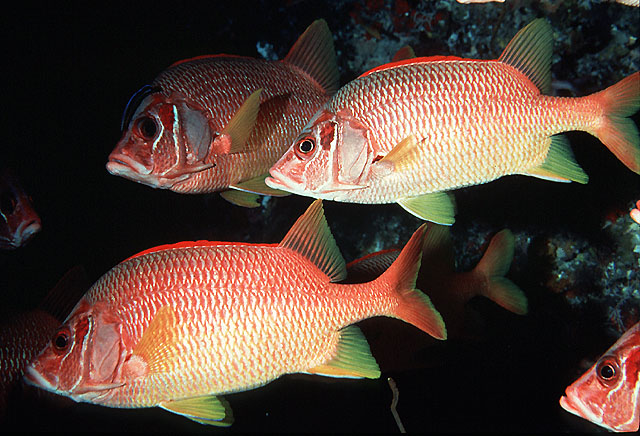| Holocentridae (Squirrelfishes, soldierfishes), subfamily: Holocentrinae |
| 51 cm FL (male/unsexed); max.weight: 2,550.0 g; max. reported age: 7 years |
|
reef-associated; marine; depth range 0 - 122 m |
| Indo-Pacific: Red Sea and East Africa (Ref. 4201) to the Hawaiian and Ducie islands, north to southern Japan, south to Australia; throughout Micronesia. |
|
Dorsal spines (total): 11-11; Dorsal soft rays (total): 14-16; Anal spines: 4-4; Anal soft rays: 9-10. Head and body red, scale edges silvery white; spinous dorsal crimson in color; other fins orange-yellow; vertically oblong crimson spot on preopercle behind eye (Ref. 4201). Five oblique scale rows on cheek; body depth 2.4-2.6 in SL; head length (HL) 2.55-2.85 in SL; lower jaw when closed slightly to moderately projecting; snout length 3.0-3.8 in HL larger than orbit diameter in adults; interorbital width 6.3-8.7 in HL; maxilla extending posteriorly to a vertical at front edge of the orbit; anterior end of nasal bone often with 2 close-set, short spines; medioposterior margin of nasal bone spineless; large nasal fossa spineless on margin; slight ridge of upper edge of suborbital bones weakly serrate; 2 subequal opercular spines; long preopercular spine, usually greater than orbit diameter in specimens at least 20 cm SL; 3rd or 4th dorsal spine longest, 1.7-2.3 in HL; 3rd anal spine 1.7-2.3 in HL (Ref. 27370).
Description: Characterized by having 5 oblique scale rows on cheek (Ref. 90102). |
| A solitary species that inhabits a variety of reef zones from reef flats to lagoon and seaward reefs to a depth of at least 122 m and is fairly common in areas not subjected to heavy spear fishing. Found under ledges during the day (Ref. 9710). Benthopelagic (Ref. 58302). Largest species of squirrelfish and the highest-bodied Sargocentron (Ref. 37816). Juvenile inhabits shallow protected reefs. A nocturnal species that feeds on crabs, shrimps and small fishes. Spine of preopercle venomous. Largest squirrelfish (Ref. 48635). Minimum depth reported taken from Ref. 128797. |
|
Least Concern (LC); Date assessed: 04 March 2015 Ref. (130435)
|
| reports of ciguatera poisoning |
|
Museum: Rotuma, USNM 287875. Viwa I., BPBM 31166. Malolo I., BPBM 31162. Viti Levu, AMNH 51667. Suva, ANSP 25770. Kandavu I., USNM 269093. Totoya I., BPBM 31114 (Ref. 27370). Also Ref. 85272. |
Source and more info: www.fishbase.org. For personal, classroom, and other internal use only. Not for publication.

